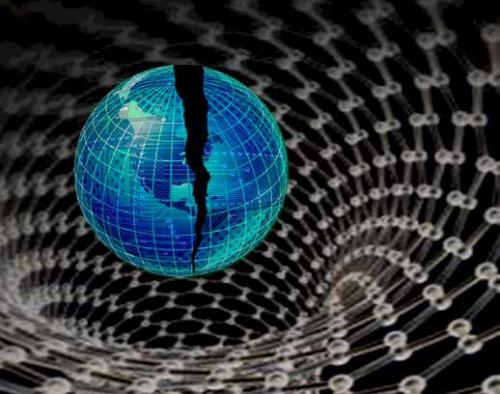The fourth industrial revolution, technologies and impacts
Governments have allowed almost all of these new technologies to be disseminated in the environment and in our bodies without even minimal evaluations of their negative impacts nor regulation.
- Opinión

According to the richest and most powerful people on this planet, the fourth industrial revolution is already underway and is the result of the convergence of robotics, nanotechnology, biotechnology, information and communication technologies, artificial intelligence and others. The World Economic Forum, that each year brings together in Davos the biggest enterprises of the planet, produced a report in 2016 affirming that with the "perfect storm" of technological changes together with what they term, aseptically, "socio-economic factors", by 2020, five million jobs will be lost, even counting the new jobs that will be created by the same process.
If they speak of a loss of five million jobs, there will surely be many more. And this is only one of the many impacts of this technological revolution that is not defined by each of these technologies in isolation, but by the convergence and the synergy among them. Among the ten key technologies – and the most disruptive – they mention the engineering of metabolic systems to produce industrial substances (that is, synthetic biology to replace fuels, plastics, aromas, flavourings, active principles, pharmaceuticals derived from indigenous knowledge); the internet of nano-things (in addition to using the internet for industrial and agricultural, production. etc., there are also nano-sensors inserted in living beings, including our bodies, to capture and receive stimuli and administration of drugs and pharmaceuticals); open ecosystems of artificial intelligence (to integrate machines with artificial intelligence to the internet of things, to social networks and to open programming, with the potential to radically change our relationship with machines and between machines) and various others, such as new materials for storing energy, "bidimensional" nano-materials, autonomous and unmanned vehicles (drones of all kinds with greater autonomy), optogenetics (live cells genetically manipulated that respond to waves of light), producing human organs in electronic chips.
In the year 2000, from the ETC Group, we called this convergence BANG (Bits, Atoms, Neurosciences, Genes), a kind of technical-sociological-economic Big Bang, better called a "Little Bang" because the technologies at a nano-scale (applied to living and material things) are the development platform for all of the others. We then observed that this "Little Bang" was forming a technological Tsunami that would have wide-scale negative impacts on the environment, health, work, the production of new weapons for war, vigilance and social control over all of us, among other things. All this in a context of the greatest corporate concentration of the industrial era, oligopolies of ever fewer companies that control immense sectors of production and technologies.
This is what is happening, but for each of us separately it is difficult to perceive in its totality and to grasp the magnitude of its impacts that are complementary. Governments, for the most part controlled by corporate interests and with the myth that technological advances are in themselves beneficial, have allowed almost all of these technologies to go ahead, to be used, sold, disseminated in the environment and in our bodies, without even minimal evaluations of their possible negative impacts and without regulation, much less with the application of the precautionary principal. A clear example is the nanotechnology industry that has launched more than 2000 lines of products onto the markets, many present in our daily life (food, cosmetics hygiene products, pharmaceuticals) which are not regulated in any part of the world.
But the Davos forum does draw up an annual report on global risks, because these risks affect their capital and investments. In the 2015 edition they state that: "The establishment of new fundamental capacities that is taking place, with synthetic biology and artificial intelligence, is particularly associated with risks that cannot be completely evaluated in a laboratory. Once the genie has come out of the bottle, there exists the possibility of producing undesirable applications or effects that cannot be anticipated at the moment of their invention. Some of these risks could be existential, that is to say, could put the future of human life in danger". When there’s a confession, you need no proof. But even though they admit this situation, they will take no measures that could affect their profits.
In this context, for a number of years, we have worked alongside other organizations, social movements, and associations of critical scientists, in the construction of a network of social evaluation and action on technologies (RED TECLA) to seek on the one hand to inform ourselves and to understand the technical horizon, its connections, impacts and implications from several perspectives (environment, health, science, gender, labour and consumption) and to strengthen ourselves to act on them.
To advance with these ideas and in challenging profit-seeking technoscience, with concrete experiences from various Latin American countries, an international seminary will take place on "Science, technology and power: critical perspectives" on November 8, from 09:30 to 14:00, in the Hemeroteca Nacional, Ciudad Universitaria, Mexico, convened by the TECLA Network, the Union of Scientists engaged with Society and the ETC Group (http://www.etcgroup.org/es). We must take into our own hands, from below, the reflection and action on these themes.
(Translated for ALAI by Jordan Bishop)
- Silvia Ribeiro is a researcher with the ETC Group.
Del mismo autor
- Guerra y alimentos 29/03/2022
- La disputa sobre quién nos alimenta 16/02/2022
- Científicos llaman a parar la geoingeniería solar 31/01/2022
- Vacunas transgénicas: experimento masivo 28/09/2021
- Cumbre de los dueños de la alimentación 07/07/2021
- Datos biométricos y capitalismo de vigilancia 14/05/2021
- COVAX: la trampa 29/04/2021
- Maíz, transgénicos y transnacionales 29/04/2021
- Prohibir cubrebocas con nanomateriales 12/04/2021
- El legado de la pandemia 16/02/2021
